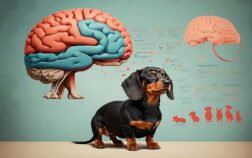IVDD in dachshunds is a famous problem that many pet owners dread. So, let’s go over the 5 main tips for how to prevent IVDD in dachshunds. There are no guarantees in life, of course, but if you follow these easy and simple tips you’ll almost certainly ensure that your Doxie never has to suffer the pain of IVDD.
What Is IVDD?
First and foremost, let’s go over what exactly Intervertebral Disc Disease (IVDD) means. This condition is essentially the hardening of the intervertebral discs on your dog’s back. Once those disks harden, they become unable to cushion the spine’s vertebrae properly which leads to pain, mobility difficulties, and – later on – neurological damage and all its nasty consequences.
What causes the intervertebral discs to harden, however? There is a hereditary component as dogs whose parents have had IVDD are significantly more likely to develop it in their own lifespan. That’s why it’s especially important to always ask your dog’s breeder for a health certificate – both for the pup and for its parents. It’s also recommended to see the parents and their litter personally as that’s a great way to see what their condition is. When adopting from a shelter, it’s equally important to ask for detailed medical information.
However, that hereditary factor is not a guarantee – it only signals a predisposition for the dog to develop IVDD. What actually “unlocks” the condition is either a direct and severe physical trauma or continuous physical stress over the dog’s back. And both of those are easily preventable.
So, while it’s smart to get a dog from good stock (and, equally important not to breed a dog if you know it’s predisposed to IVDD), there are still ways how to prevent IVDD in dachshunds regardless of their lineage.
5 Tips For How To Prevent IVDD In Dachshunds
Of course, there are way more than just 5 things you can do. Feeding your dog a proper diet, for example, is strongly recommended as dachshunds need extra calcium and phosphorous to stay healthy. However, the biggest and main tips that will almost certainly prevent IVDD and other back problems in your dachshund are as follows:
1. Don’t Let Your Dachshund From Becoming Overweight
Obesity is a major risk factor for many conditions, including back problems. Simply put, if your dog is overweight, that will result in further stress on its spine. If you’re curious about how to feed a dachshund, we’ve talked about that here.
2. Avoid Repeated Trauma and High-impact Activities
Direct physical trauma or repeated high-impact activities can harm your dog’s back either instantly or over time. This includes running up and downstairs, jumping out of and in the car, jumping on and off the furniture, or simply running for too long at high speed. This doesn’t mean that you shouldn’t let your dog upstairs or on the sofa, of course. However, installing some ramps on the staircase or on the side of the sofa will drastically improve your dog’s health outcome.
3. Focus On Extensive But Low-impact Exercise
Doxies need exercise to stay healthy and fit but how do you make that exercise “low-impact”? Well, anything as simple as a brisk walk can suffice if it’s not too short. Some simple playtime at home is also wonderful if it doesn’t include too much jumping. And then there’s the king of canine exercise – swimming.

Read more about: Do Dachshunds Like To Swim and Are They Good At It?
4. Always Walk Your Dachshund With A Harness
Leashes are simple and easy to use but they can lead to both neck and back problems, especially on breeds like the dachshund. A nice harness prevents such issues almost entirely. Not to mention that it makes it much easier to pick up your dachshund when you need to go up in the car or a staircase.
5. Handle Your Dog With Care
The broadest and simplest tip is to just handle your dog carefully. This means not dropping your dog from too high after hugging it, not picking it up in unorthodox and uncomfortable ways, and so on. The most straightforward way how to prevent IVDD in dachshunds is to treat them with the care they’d need if they already had IVDD.
FAQs
[rank_math_rich_snippet id=”s-a2ba2839-c251-49de-8fe0-ad3000499272″]




